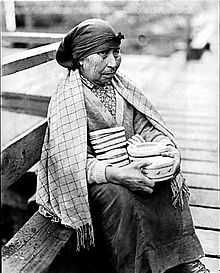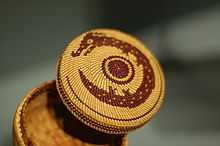Nuu-chah-nulth
|
Three Nuu-chah-nulth children in Yuquot, 1930s | |
| Total population | |
|---|---|
| 8000 | |
| Regions with significant populations | |
| Canada (British Columbia) | |
| Languages | |
| English, Nuu-chah-nulth language | |
| Related ethnic groups | |
| Kwakwaka'wakw, Makah; other Wakashan peoples |
The Nuu-chah-nulth (/nuːˈtʃɑːnʊlθ/;[1] Nuu-chah-nulth: [nuːt͡ʃaːnˀuɬ]),[2] also formerly referred to as the Nootka, Nutka, Aht, Nuuchahnulth, or Tahkaht.[3] are one of the Indigenous peoples of the Pacific Northwest Coast in Canada. The term 'Nuu-chah-nulth' is used to describe fifteen separate but related nations whose traditional home is in the Pacific Northwest on the west coast of Vancouver Island.
In precontact and early post-contact times, the number of nations was much greater, but smallpox and other consequences of contact resulted in the disappearance of some groups and the absorption of others into neighbouring groups. The Nuu-chah-nulth are related to the Kwakwaka'wakw, the Haisla, and the Nitinaht. The Nuu-chah-nulth language is part of the Wakashan language group.
History

When James Cook first encountered the villagers at Yuquot in 1778, they directed him to "come around" (Nuu-chah-nulth nuutkaa is "to circle around")[4] with his ship to the harbour. Cook interpreted this as the native's name for the inlet—now called Nootka Sound—which came to be applied to the inhabitants of the area. In 1978 the term Nuu-chah-nulth (nuučaan̓uł, meaning "all along the mountains")[4] was chosen as a collective term to describe the closely related nations of western Vancouver Island. This was the culmination of the 1967 alliance forged between the various nations in order to present a unified political voice. The Makah of Washington are closely related to the Nuu-chah-nulth.
The Nuu-chah-nulth were among the first Pacific peoples north of California to come into contact with Europeans. Competition between Spain and the United Kingdom over control of Nootka Sound led to a bitter international dispute around 1790, called the Nootka Crisis, which was settled with the Nootka Conventions of the 1790s, when Spain agreed to abandon its exclusive claims to the North Pacific coast. Negotiations to settle the dispute were handled under the hospitality of a powerful chief of the Mowachaht Nuu-chah-nulth of Nootka Sound, Maquinna.
Maquinna captured the American trading ship Boston in March 1803, and he and his men killed the captain and all the crew, sparing only two, whom they kept as slaves. John R. Jewitt wrote a classic tale of captivity about his years with them and his reluctant integration into their society. This book is entitled Narrative of the Adventures and Sufferings of John R. Jewitt, only survivor of the crew of the ship Boston, during a captivity of nearly three years among the savages of Nootka Sound: with an account of the manners, mode of living, and religious opinions of the natives.[5] It is a useful source of historical information on many aspects of daily life, including the hunting and preparing of food, the making of clothing and implements, the fashions of hairdos and body decoration, the system of government and punishments, canoes, warfare, and spiritual beliefs.
In 1811 the trading ship Tonquin was blown up in Clayoquot Sound when its efforts to trade were turned into an attack by Tla-o-qui-aht in revenge for an insult by the ship's captain. The sole surviving crew member, after the rest were killed, set fire to the ship's magazine in order to destroy the ship. Many natives were killed, and only one crew member survived to tell the tale.
At the time of early contact with European explorers up until 1830, more than 90% of the Nuu-chah-nulth were killed by malaria, and smallpox, and by cultural turmoil resulting from contact with Westerners.
Tribes

Nuu-chah-nulth band governments today are:
- Ahousaht First Nation: (population over 2,000) formed from the merger of the Ahousaht and Kelsemeht bands in 1951;
- Ehattesaht First Nation; (population 294)
- Hesquiaht First Nation; (population 653)
- Kyuquot/Cheklesahht First Nation; (population 486)
- Mowachaht/Muchalaht First Nations: (population 520) formerly the Nootka band;
- Nuchatlaht First Nation; (population 165)
- Huu-ay-aht First Nation: (formerly Ohiaht); (population 598)
- Hupacasath First Nation (formerly Opetchesaht); (256)
- Tla-o-qui-aht First Nations: (formerly Clayoquot); (population 881)
- Toquaht First Nation; (population 117)
- Tseshaht First Nation; (population 1002)
- Uchucklesaht First Nation; (population 181)
- Ucluelet First Nation. (population 606)
Total population for the 14 nations in the Nuuchahnulth Tribal is 8,147 according to the Nuuchahnulth Tribal Council Indian Registry from February 2006.
The Ditidaht First Nation (population 690), while politically and culturally affiliated with the Nuu-chah-nulth, are independently referred to, similar to the Pacheedaht First Nation, who are not politically affiliated with the Nuu-chah-nulth Tribal Council.
After contact, the advent of foreign diseases spread and decimated some tribes, including the Hupacasath, Huu-ay-aht, Ka;'yu;k't'h'/Che;k'tles7et'h', and the Tseshaht.
Culture


The Nuu-chah-nulth were one of the few groups on the Pacific Coast who hunted whales. Whaling is essential to Nuu-chah-nulth culture and spirituality. It is reflected in stories, songs, names, family lines, and numerous place names throughout the Nuu-chah-nulth territories. Perhaps the most famous Nuu-chah-nulth artifact is the Yuquot Whalers' Shrine, a ritual house-like structure used in the spiritual preparations for whale hunts. Composed of a series of memorial posts depicting spirit figures and the bones of whaling ancestors, it is presently in storage at the American Museum of Natural History in New York. It was the subject of the film The Washing of Tears, directed by Hugh Brody, which recounts the rediscovery of the bones and other artifacts at the museum and the travels of the Mowachaht people, the shrine's original owners, in seeking to repossess them.
Food
While salmon has always been an important part of Nuu-chah-nulth people's diet, they also traditionally ate various land animals, edible plants, waterfowl and seafoods. Since time immemorial, Nuu-chah-nulth people have relied on their surroundings for sustenance. It is through this relationship that they have defined their culture, nutritional needs, genetic makeup, and economies.
In an effort to strengthen the revival of traditional diets, the Nuu-chah-nulth Tribal Council and sixteen Nuu-chah-nulth Nations have contributed to the publication of a traditional wild food cookbook, "Čamus: West Coast Cooking Nuu-chah-nulth Style". The 90-page cookbook focuses on traditional recipes and seasonal ingredients from the west coast of Vancouver Island and Northern Washington. Marrying First Nations cuisine with cooking tips, cultural observations, and oral history anecdotes, Čamus (chum-us) features traditional and wild ingredients.
Bringing together the wisdom of the elders with the culinary artistry of the West Coast's unique tastes, Čamus explores the art of how to butterfly a salmon and how to can fish, as well as delectable recipes for marinated seaweed, steam pit cooking, and Nuu-chah-nulth upskwee. Čamus illuminates a traditional way of eating while promoting a healthy lifestyle. Living examples of the tenets espoused by the slow food movement, which has grown to include 80,000 members in over 100 countries, the First Nations of Vancouver Island's west coast and northern Washington link family and community in their respectful treatment of their territories' freshest ingredients.
Potlatch
The Nuu-chah-nulth and other Pacific Northwest cultures are famous for their potlatch ceremonies, in which the host honours guests with generous gifts. The term 'potlatch' is ultimately a word of Nuu-chah-nulth origin. The purpose of the potlatch is manifold: redistribution of wealth, maintenance conference and recognition of social status,[6][7] cementing alliances, the celebration and solemnization of marriage, and commemoration of important events.
See also
- Nuu-chah-nulth Tribal Council
- Nuu-chah-nulth mythology
- Maritime Fur Trade
- Maquinna
- Wickaninnish
- Uu-a-thluk, aquatic management organization
Notes
- ↑ "Guide to Pronunciation of B.C. First Nations" (PDF). British Columbia Ministry of Aboriginal Relations and Reconciliation. Retrieved 5 July 2010.
- ↑ "Nuučaan̓uł (Nuu-chah-nulth, Nootka)". Languagegeek. Retrieved 5 July 2010.
- ↑ Some account of the Tahkaht language, as spoken by several tribes on the western coast of Vancouver island , Hatchard and Co., London, 1868
- ↑ 4.0 4.1 Campbell, Lyle (1997). American Indian Languages: The Historical Linguistics of Native America. Oxford: Oxford University Press, pg. 396 n.34
- ↑ Middletown, Connecticut, printed by Loomis and Richards, 1815. Full digital text available here
- ↑ "Potlatch". Oxford English Dictionary. Retrieved 2007-04-26.
- ↑ "Potlatch". Dictionary.com. Retrieved 2007-04-26.
References
- Ellis, David, W.; & Swan, Luke. (1981). Teachings of the Tides: Uses of Marine Invertebrates by the Manhousat People. Nanaimo, British Columbia: Theytus Books.
- Hoover, Alan L. (Ed.). (2002). Nuu-Chah-Nulth Voices: Histories, Objects & Journeys. Victoria, B. C.: Royal British Columbia Museum.
- Kim, Eun-Sook. (2003). Theoretical Issues in Nuu-Chah-Nulth Phonology and Morphology. (Doctoral Dissertation, University Of British Columbia, Department Of Linguistics).
- McMillian, Alan D. (1999). Since the Time of the Transformers: The Ancient Heritage of Nuu-Chah-Nulth, Ditidaht, and Makah. Vancouver: UBC Press.
- Sapir, Edward. (1938). Glottalized Continuants in Navaho, Nootka, and Kwakiutl (With a Note on Indo-European). Language, 14, 248–274.
- Sapir, Edward; & Swadesh, Morris. (1939). Nootka Texts: Tales and Ethnological Narratives with Grammatical Notes and Lexical Materials. Philadelphia: Linguistic Society Of America.
- Sapir, Edward; & Swadesh, Morris. (1955). Native Accounts of Nootka Ethnography. Publication of the Indiana University Research Center in Anthropology, Folklore, and Linguistics (No. 1); International Journal of American Linguistics (Vol. 21, No. 4, Pt. 2). Bloomington: Indiana University Research Center in Anthropology, Folklore, and Linguistics. (Reprinted 1978 In New York: AMS Press, ISBN 0-404-11892-5).
- Shank, Scott; & Wilson, Ian. (2000). Acoustic Evidence for ʕ As a Glottalized Pharyngeal Glide in Nuu-Chah-Nulth. In S. Gessner & S. Oh (Eds.), Proceedings of the 35th International Conference on Salish and Neighboring Languages (Pp.&Nbsp;185–197). UBC Working Papers in Linguistics (Vol. 3).
External links
| Wikimedia Commons has media related to Nuu-chah-nulth. |
- Nuu-chah-nulth Home Page
- An extract from the forthcoming Nuuchahnulth Dictionary
- Nootka Texts
- Bibliography of Materials on the Nuuchanulth Language (YDLI)
- Nuuchahnulth (Nootka) (Chris Harvey's Native Language Font, & Keyboard)
- map of Northwest Coast First Nations (including Nuu-chah-nulth)
- The Wakashan Linguistics Page
- Internet Movie Database on The Washing of Tears
| ||||||||||||||||||||||||||||||||||
| ||||||||||||||||||||||||||||||||||||||||||||

